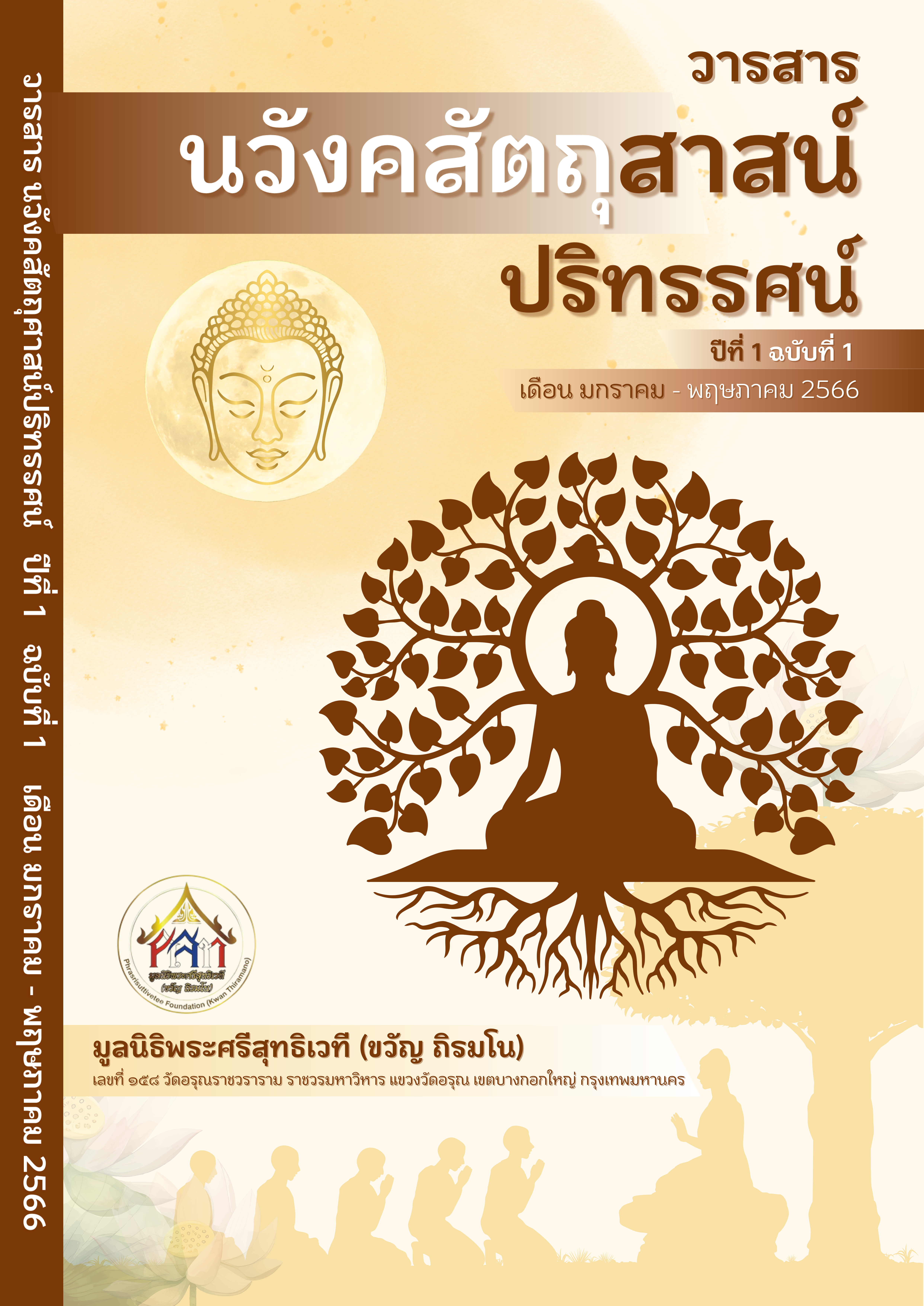The Mantra Recitation in order to Meditation Cultivating Leading to Vipassana Practice
Main Article Content
Abstract
This academic article aims to analyze Mantra Recitation in order to Meditation Cultivating Leading to Vipassana Practice. The Buddha’s words recitation or chanting is beneficial to Buddhists as merit. Even though routine exercises, studies, and recitation or chanting did not have a particular Buddha’s order, but his disciples laid down as ‘Vatta’ later. If any Buddhist follows, it will bring about prosperity, but if not, there is no disciplinary actions, rather they will not get merit from Triple Gem refuge. At the present, there is a Sangh’s penalty to the monks who did not follow because of routine breaking, that is, the unity of Sangha within their own monastery. Conducting morning and evening chanting has been seen as the Buddha attendant, and listening his teaching found in chanted discourses. Buddha’s word chanting is one among 10 routine conducts of Buddhists. It can be said that the wise disciple in the past, has done great value to next generations. Recitation refers to the Buddha’s words, used to spread of Buddhism, the reciter or listeners from human world, the gods, and the Brahma world, all appreciate to such powerful and ineffable recitation. In addition, the mantra recitation also mentions to the Buddha’s grace of great compassion, purity and wisdom. It is considered as enhancing the dignity to life, relieving desires as taught by Buddha, Sangha and Arahant. It also sharpens the mind, setting the mind on wholesome states, united, strong, confident, not shaky, not distracted, being in still state or Samadhi which later leading to Samādhindriya, Samādhibala, Sammāsamādhi, Samādhisambojjhanga, which is the process of noble path. After that with mindfulness, the meditator observes all objects happening in present moment, interring into Noble Eightfold Path, realizing everything as they really were, and finally attaining the liberation, Nibbana, which the end of suffering.
Article Details

This work is licensed under a Creative Commons Attribution-NonCommercial-NoDerivatives 4.0 International License.
เนื้อหาและข้อมูลในบทความที่ลงตีพิมพ์ในวารสาร นวังคสัตถุสาสน์ปริทรรศน์ถือเป็นข้อคิดเห็นและความรับผิดชอบของผู้เขียนบทความโดยตรงซึ่งกองบรรณาธิการวารสาร ไม่จำเป็นต้องเห็นด้วย หรือร่วมรับผิดชอบใด ๆ บทความ ข้อมูล เนื้อหา รูปภาพ ฯลฯ ที่ได้รับการตีพิมพ์ในวารสาร นวังคสัตถุสาสน์ปริทรรศน์ถือเป็นลิขสิทธิ์ของวารสาร นวังคสัตถุสาสน์ปริทรรศน์หากบุคคลหรือหน่วยงานใดต้องการนำทั้งหมดหรือส่วนหนึ่งส่วนใดไปเผยแพร่ต่อหรือเพื่อกระทำการใด ๆ จะต้องได้รับอนุญาตเป็นลายลักอักษรจากวารสาร นวังคสัตถุสาสน์ปริทรรศน์ก่อนเท่านั้น
References
คณะศิษย์อาจารย์นิศา เชนะกุล. การเจริญสติปัฏฐาน. กรุงเทพมหานคร: ห้างหุ้นส่วนจำกัด ฟันนีพับ
บลิชชิ่ง, 2540.
พระธรรมธีรราชมหามุนี. หลักปฏิบัติสมถะ-วิปัสสนากรรมฐาน. กรุงเทพมหานคร: โรงพิมพ์มหาจุฬาลงกรณราชวิทยาลัย, 2531.
________. วิปัสสนาญาณโสภณ. พิมพ์ครั้งที่ 3. กรุงเทพมหานคร: ห้างหุ้นส่วนจำกัด เครืออนันต์การพิมพ์, 2546.
________. หลักปฏิบัติสมถะ-วิปัสสนากรรมฐาน. กรุงเทพมหานคร: โรงพิมพ์มหาจุฬาลงกรณราชวิทยาลัย, 2531.
พระอุปติสสเถระ. คัมภีร์วิมุตติมรรค. แปลโดย พระธรรมโกศาจารย์ (ประยูร ธมฺมจิตฺโต) และคณะ แปลจากฉบับภาษาอังกฤษ ของพระเอฮารา พระโสมเถระ และพระเขมินทเถระ. พิมพ์ครั้งที่ 6. กรุงเทพมหานคร: สํานักพิมพ์ศยาม, 2554.
พุทธทาสภิกขุ. การทำสมาธิและวิปัสสนาที่แท้สมาธิวิปัสสนาตามวิธีธรรมชาติ. กรุงเทพมหานคร: โรงพิมพ์ธรรมสภา, 2540.
ภัททันตอาสภเถระ ธัมมาจริยะ. วิปัสสนาทีปนีฎีกา กรุงเทพมหานคร: พี แอนด์ โฟ, 2526.
มหาจุฬาลงกรณราชวิทยาลัย. พระไตรปิฎกภาษาไทย ฉบับมหาจุฬาลงกรณราชวิทยาลัย. กรุงเทพมหานคร: โรงพิมพ์มหาจุฬาลงกรณราชวิทยาลัย, 2539.
สมเด็จพระพุทธโฆษาจารย์ (ป.อ. ปยุตฺโต). “พระไตรปิฎกสิ่งที่ชาวพุทธต้องรู้”. วารสาร Manusya: Journal Of Humanities สำนักกองทุนสนับสนุนการวิจัย และจุฬาลงกรณมหาวิทยาลัย. ฉบับพิเศษ 4. (2545): 93.
________. พุทธธรรม ฉบับปรับปรุงและขยายความ. พิมพ์ครั้งที่ 11. กรุงเทพมหานคร: โรงพิมพ์มหาจุฬาลงกรณราชวิทยาลัย, 2552.

